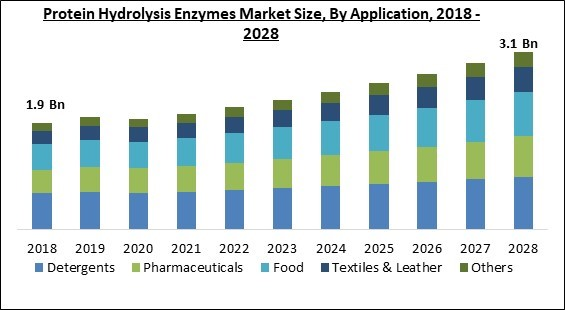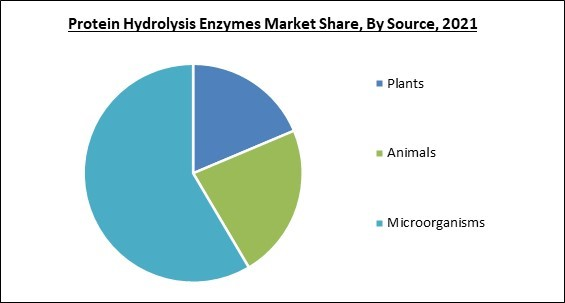The Global Protein Hydrolysis Enzymes Market size is expected to reach $3.1 billion by 2028, rising at a market growth of 6.4% CAGR during the forecast period.
The amino protein known as a protein hydrolysate enzyme is utilized in the hydrolysis of bonds in various applications. The main application of protein hydrolysates is the elimination of protein stains. The expansion is being driven by the expanded commercial use of protein hydrolysate enzymes. While the market is growing as a result of rising demand in developed economies.
The majority of the enzymes utilized for protein hydrolysis originate from the microbial, plant, and animal sources, including pancreatin and pepsin, papain from papaya, ficin from figs, and bromelain from pineapple (such as Alcalase). Proteins are hydrolyzed by proteolytic enzymes at the ideal temperature and pH, and they often target particular peptide bonds, resulting in the digestion of amino acids and peptides of various sizes. Unlike plant enzymes, which are more widely specific in their action, enzymes derived from animal sources are more particular in their location of action.
Particularly in terms of a quicker rate of absorption as well as better muscle protein synthesis, protein hydrolysates/hydrolyzed proteins clearly outperform intact proteins. It has a wide range of applications and could be used successfully by people recuperating from illness or accident, older people with frequent malabsorption, as well as people who indulge in physical activity for a quicker recovery after working out.
According to certain studies, hydrolyzed protein is superior to intact protein at promoting skeletal muscle protein synthesis. Protein that has been hydrolyzed has been linked to the following advantages. Protein hydrolysates are known to boost postprandial amino acid availability, accelerate protein absorption and digestion from the gut, and tend to enhance the rate at which dietary amino acids are incorporated into skeletal muscle protein. These effects are all seen in comparison to intact protein.
The market research report covers the analysis of key stakeholders of the market. Key companies profiled in the report include Novozymes A/S, Associated British Foods PLC (Wittington Investments Limited), Koninklijke DSM N.V., DuPont de Nemours, Inc., BASF SE, Advanced Enzyme Technologies Limited, Chr. Hansen Holding A/S, Dyadic International, Inc., Amano Enzyme, Inc., and Biocatalysts Limited (Brain AG).
The amino protein known as a protein hydrolysate enzyme is utilized in the hydrolysis of bonds in various applications. The main application of protein hydrolysates is the elimination of protein stains. The expansion is being driven by the expanded commercial use of protein hydrolysate enzymes. While the market is growing as a result of rising demand in developed economies.
The majority of the enzymes utilized for protein hydrolysis originate from the microbial, plant, and animal sources, including pancreatin and pepsin, papain from papaya, ficin from figs, and bromelain from pineapple (such as Alcalase). Proteins are hydrolyzed by proteolytic enzymes at the ideal temperature and pH, and they often target particular peptide bonds, resulting in the digestion of amino acids and peptides of various sizes. Unlike plant enzymes, which are more widely specific in their action, enzymes derived from animal sources are more particular in their location of action.
Particularly in terms of a quicker rate of absorption as well as better muscle protein synthesis, protein hydrolysates/hydrolyzed proteins clearly outperform intact proteins. It has a wide range of applications and could be used successfully by people recuperating from illness or accident, older people with frequent malabsorption, as well as people who indulge in physical activity for a quicker recovery after working out.
According to certain studies, hydrolyzed protein is superior to intact protein at promoting skeletal muscle protein synthesis. Protein that has been hydrolyzed has been linked to the following advantages. Protein hydrolysates are known to boost postprandial amino acid availability, accelerate protein absorption and digestion from the gut, and tend to enhance the rate at which dietary amino acids are incorporated into skeletal muscle protein. These effects are all seen in comparison to intact protein.
COVID-19 Impact Analysis
The government implemented lockdowns due to the coronavirus outbreak, which briefly hampered the operations of various companies, including the protein hydrolysis enzyme industry. On the other side, the market expansion was propelled by rising hygiene concerns and initiatives to stop the spread of infectious diseases such as the coronavirus. The World Health Organization (WHO) also advised adopting healthy diet programs to battle the effects of COVID-19 disease on the human body, which led to an increase in sedentary work and an increase in the preference for protein concentrates, supplements, powders, and hydrolysates. As a result, COVID-19 had a combined effect on the expansion of the market for protein hydrolysis enzymes.Market Growth Factors
Growing Use As Sport Nutrition
The need for sports nutrition is rising as young people around the world show an increasing interest in sports and wellness activities. Sports drinks with whey protein have become more common in recent years. For Indian consumers, the concept of a protein shake is relatively new. However, as the product progressively acquires popularity and availability, the market for sports drinks has seen a fantastic growth rate in terms of both volume and value.Greater Interest In Organic And Eco-Friendly Goods
The desire for natural and nutritious food ingredients is on the rise, and there is also a rising understanding of the health problems linked to eating artificial food additives. It has been demonstrated that using protein hydrolysis enzymes instead of chemicals enhances product quality and lowers environmental pollution. Protein hydrolysis enzyme developments will continue to make it easier to use these enzymes to create a sustainable environment and enhance human existence.Market Restraining Factors
Some Of These Enzymes Have Side Effects
Despite of various benefits offered by them, it has been discovered that certain protein hydrolysis enzymes can cause adverse reactions in human beings. If consumed in large quantities, bromelain can cause gastrointestinal issues such as nausea, diarrhea, and vomiting, as well as a menstrual flow that is heavier than usual. discovered that bromelain has an antiplatelet impact on blood, which results in an increased risk of bleeding.Sources Outlook
Based on sources, the protein hydrolysis enzymes market is segmented into microorganisms, animals, and plants. In 2021, the microorganism segment dominated the protein hydrolysis enzymes market with the maximum revenue share. This is because the bacteria's source has numerous applications in detergents and cleaning supplies. Additional benefits of microbial protein hydrolysis enzyme sources include low production costs, extensive use in the fermentation industry, and use in genetic engineering, all of which are anticipated to increase demand for microorganism sources internationally.Product Outlook
On the basis of product, the protein hydrolysis enzymes market is divided into animal product, plant product and microbial product. The microbial product segment witnessed the highest revenue share in the protein hydrolysis enzymes market in 2021. Due to the fact that microbial protein hydrolysis enzymes are utilized in a variety of industrial processes, goods, and particularly in the food business, the market is expanding in this region.Application Outlook
Based on application, the protein hydrolysis enzymes market is segmented into detergents, pharmaceutical, food, textile & leather and other applications. The food segment acquired a significant revenue share in the protein hydrolysis enzymes market in 2021. Protein hydrolysis enzymes are employed in a variety of culinary products, including bakery goods, ice cream, and bread. This is due to the fact that their traits support dough strength, homogeneity, volume expansion, and crumb grain.Regional Outlook
Region wise, the protein hydrolysis enzymes market is analyzed across North America, Europe, Asia Pacific and LAMEA. In 2021, the North America region led the protein hydrolysis enzymes market by generating the maximum revenue share. Protease enzymes are now used in a variety of products, including detergents, medications, food, textiles, and leather owing to technological improvements. Due to the region's increased demand for meat and fortified foods, the regional market for protein hydrolysis enzymes has expanded.The market research report covers the analysis of key stakeholders of the market. Key companies profiled in the report include Novozymes A/S, Associated British Foods PLC (Wittington Investments Limited), Koninklijke DSM N.V., DuPont de Nemours, Inc., BASF SE, Advanced Enzyme Technologies Limited, Chr. Hansen Holding A/S, Dyadic International, Inc., Amano Enzyme, Inc., and Biocatalysts Limited (Brain AG).
Scope of the Study
By Source
- Plants
- Animals
- Microorganisms
By Application
- Detergents
- Pharmaceuticals
- Food
- Textiles & Leather
- Others
By Product
- Microbial Product
- Alkaline Protease
- Acid Protease
- Neutral Protease & Others
- Plant Product
- Papain
- Bromelain & Others
- Trypsin
- Pepsin
- Renin & Others
- Animal Product
- Trypsin
- Pepsin
- Renin & Others
By Geography
- North America
- US
- Canada
- Mexico
- Rest of North America
- Europe
- Germany
- UK
- France
- Russia
- Spain
- Italy
- Rest of Europe
- Asia Pacific
- China
- Japan
- India
- South Korea
- Singapore
- Malaysia
- Rest of Asia Pacific
- LAMEA
- Brazil
- Argentina
- UAE
- Saudi Arabia
- South Africa
- Nigeria
- Rest of LAMEA
Key Market Players
List of Companies Profiled in the Report:
- Novozymes A/S
- Associated British Foods PLC (Wittington Investments Limited)
- Koninklijke DSM N.V.
- DuPont de Nemours, Inc.
- BASF SE
- Advanced Enzyme Technologies Limited
- Chr. Hansen Holding A/S
- Dyadic International, Inc.
- Amano Enzyme, Inc.
- Biocatalysts Limited (Brain AG)
Unique Offerings
- Exhaustive coverage
- The highest number of Market tables and figures
- Subscription-based model available
- Guaranteed best price
- Assured post sales research support with 10% customization free
Table of Contents
Chapter 1. Market Scope & Methodology
Chapter 2. Market Overview
Chapter 3. Global Protein Hydrolysis Enzymes Market by Source
Chapter 4. Global Protein Hydrolysis Enzymes Market by Application
Chapter 5. Global Protein Hydrolysis Enzymes Market by Product
Chapter 6. Global Protein Hydrolysis Enzymes Market by Region
Chapter 7. Company Profiles
Companies Mentioned
- Novozymes A/S
- Associated British Foods PLC (Wittington Investments Limited)
- Koninklijke DSM N.V.
- DuPont de Nemours, Inc.
- BASF SE
- Advanced Enzyme Technologies Limited
- Chr. Hansen Holding A/S
- Dyadic International, Inc.
- Amano Enzyme, Inc.
- Biocatalysts Limited (Brain AG)
Methodology

LOADING...










